FS Aconit was a planned class of cheap but well armed, versatile Frigate, but ended as a single frigate built for the Marine Nationale in the Cold War when the program was cancelled. She was built in 1968-73, in commission until 1997. She was designed around the idea of a cheap, fast single shaft ASW corvette to hunt down Soviet subs, but never lived to expectation and the whole program was cancelled. She became later a test bed for a bit like La Galissonnière before, contributed in some ways to create the design of the next Tourville class in opposition. She was named after the awarded FFL corvette Aconit of World War II.
Development
The Type C65 corvette (not a frigate at first) was designed as a cheap type of ASW corvette to hunt down Soviet submarines if the cold war was to turn hot. She was intended to have improved performance and developed around a new system just developed for the task: The French DUBV43 towed active sonar, with the “hammer” being the already new tested and proven Malafon anti-submarine missile, French loose equivalent to ASROC. Some authors would later consider the class as the ultimate evolution of the T 47 destroyers of the fifties, squadron escorts specialized in anti-submarine warfare. For others, like Conways she was a French equivalent to the USN Knox class. The only difference with the T47 were the old Bofors 375 mm ASWRL replaced by a 305 mm model.
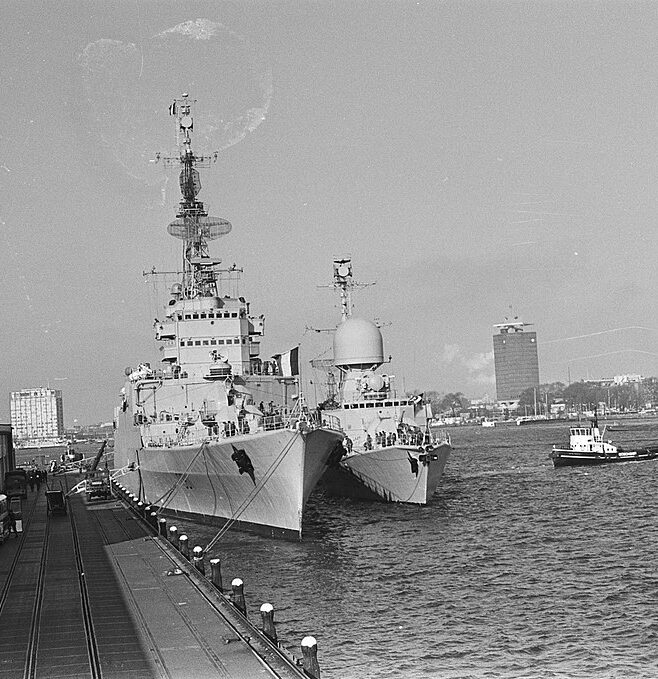
Aconit and Colbert in Amsterdam during the visit of Vice-Admiral De Gaulle, 1970s
But choices made in powerplant, also new and radical in its approach with a single turbine, not only took time, but never delivered the awaited performances. Indeed it was chosen a single propeller, which meant agility would not be as good as classic twin-shaft arrangement of destroyers and frigates, but it was consistent with a frigate.
The single prop choice also was chosen for fuel economy and cost, allowing a relatively large production, as well as less drag and cavitation which can parasite the sonar work. In the end, this proved a bad decision. The other point not considered during her design, amazing given in 1968 the helicopter was definitely considered one if not the best asset in ASW, was the lack of facilities for helicopters. Apart a simple helideck there was no space for a hangar. This was significant drawback, dictated by compromises in size and displacement caused by the single prop. Eventually the whole C65 programme, comprising initially five ships was cancelled outright in 1973, and FS Aconit, after six years of construction, remained single in class. The design of oceanic ASW ships was completely rethought, leading to the much better C67 (then F67) program, also known as the Tourville class.
Design of the class
Hull and general design
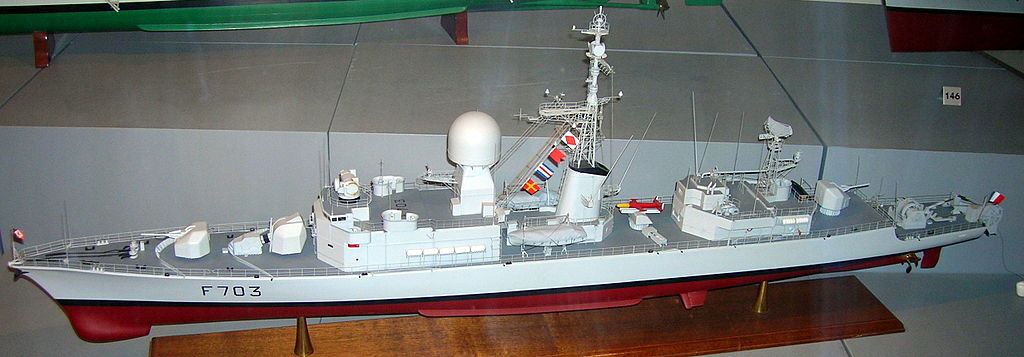
FS Aconit was at first seen as a scaled down hull similar to the previous Suffren, with a long forecastle about 4/5 her length and lower deck aft for the towed sonar. She had clean hull lines but a large bulbous bow for the large fixed DUBV23 hull sonar using active detection, a sloped deck, and long flat section starting aft of the forward main gun. The two 100 mm guns, both on the same deck level, one forward and one aft were intended for AA defence, and this was completed by the two main ASW assets, the Malafon aft amidship between superstructure islands, and the forward triple ASW launcher. At 3,135 tonnes standard and 3,870 full load she was half the size of the previous Suffren class frigates and more in the earlier T-47/53 types range. The hull ratio was around 1/9 at 417 ft x 44 ft and her draught was important due to the hull sonar.
The superstructures were blocky, with the bridge being low, fully enclosed, three-faceted narrow passageways either side. It supported the main fire control system for both guns, right aft of the bridge and at the roof rear, was located the prominent radome mast. There was single funnel, raked, amidship, with a lattice main mast anchored at its top, supporting the main aerials. There was a smaller island structure aft, supporting a small half-mast and sensors. Her layout influenced also the design of the A69 class Avisos. Her crew comprised 15 officers, 103 petty opfficers and NCOs, plus 114 ratings. She possessed two utility motor boats amidships on davits, and 14 life rafts in containers along the main bridge and rear structure’s walls. She also had three anchors, tow main and one center in the bowsprit.
Powerplant
On paper, the machinery arrangement was designed to bring her to 30+ knots, and thus to keep pace with Soviet SSNs, but that was never achieved. The single five-bladed propeller was connected via a single shaft to a single geared Rateau steam turbine, fed by two admiralty HP 3-drum boilers. This produced a total output of 28,650 hp (21,364 kW). Thuis power coulkd be still brought by overheating boilers to 31,500 cv (23,168 kw) for short speed runs. In addition her electric generarors fed by diesels could bring her an additional 2,960 kW to feed electrical systems and sensors when at anchor.
She had only a top speed of 27 knots (50 km/h; 31 mph) on trials, meaning c25 at best in heavy weather and fully loaded, quite insufficient for Atlantic patrol, perhaps 30 knots for short runs. So at first assigned to the Mediterranean. To compensate for the single shaft she had a slightly larger rudder as usual, and her agility was kept reasonable for her task. As for range, again it was a better fit for the Mediterranean, with a run at 27 knots possible over 1,600 nmi (3,000 km; 1,800 mi) and 5,000 nmi (9,300 km; 5,800 mi) when cruising at 18 knots (33 km/h; 21 mph). She briefly served in Toulon, but in the end she was based at Ile Longue (Long island), Brest Naval Base, to escort French SSBNs until their “dilution” in high seas.
Armament
Main: 2x 100mm M1968 DP
100 mm (3.9 in) Modèle 1968 were the last evolution of this dual-purpose gun with an anti-surface range of 9 nmi (17 km; 10 mi), 13.5 kg (30 lb) warhead shells and in AA fire, air fuse shell at 4.4 nmi (8.1 km; 5.1 mi), 80 rounds per minute, fully automated. Coupled with a CTMS (multisensor fire control) coupled with DRBC-33A radar and a Piranha II IR deviation meter plus TV camera to guide the 100mm guns as well as two DMA-a Panda optical stations.
Malafon ASWM
A ramp with relatively large missile carrying a 21-in L5 acoustic torpedo. Each ship carried 13 missiles. In short: Single launcher arm, radar-guided during initial flight. Payload 450mm (18 in) L5 torpedo payload. The missile accelerated to 830 km/h (520 mph), flew at 100 metres (330 ft) altitude and corrected trajectory via radio control up to 13 km (8.1 mi). The dropped homing torpedo swam at 30 knots (56 km/h; 35 mph) over 5 km (3.1 mi) to the target.
See more here (FR)
305mm ASWR
The 12-inches quad (305 mm) ASW rocket launcher is the replacement for the Bofors 375 mm of the T-47, but it only had a limited service time. It was also in service with the A69 avisos and La Galissonière.
the quadruple 305 mm (12-in) self-loading mortar launched 230 kg ASW charges from 400 to 3000 meters in range. The mortar also had a firing capability against ground targets with a lighter projectile (100 kg) but at a 6000 m range. See the T53 class for more details.
L5 Torpedoes
There were two fixed catapults buried into the structure to fire the L5 ASW heavy torpedo, 21 inches or 533 mm. They could operate at depths of 1,800 feet (550 m) if needed, and were powered by a Silver-zinc Battery to 7,700 yards (7,000 m) at 35 knots for Mod.1, later 10,000 yards for Mod.4 and carried a 440 lbs. (200 kg) HBX-3 or TNT warhead. It was also capable of engaging a surface target.
MM-40 Exocet SSM
They replaced the forward mounted 305 mm ASW RL in four single canister. The MM40 had a range of 72 km for the Block 2, 200 km for the Block 3.
AA
From 1992 she received two Mark 38 Oerlikon 20 mm cannons, installed on the bridge’s roof, and two 12.7 mm (0.50 in) Browning machine guns on pintles, location unknown. They were intended to deal with asymetric threats in ports.
Helicopter
Aérospatiale Alouette III used for ASW tracking and SAR, liaison, carrying aerial torpedoes for ASW. Not used often.
Sensors
As built
-DRBC32B fire control radar, atop the bridge forward
-DRBV-13 surveillance radar, large radom on bridge.
-Decca 1226 navigation radar atop the mainmast
-DRBV22A air surveillance radar, located on the aft half-mast
-DUBV23 active sonar in the bow
-DUBV43 towed active sonar, aft on the lower deck hull section
-Passive ETBF DSBV62C antenna, datalink, combat computer SENIT 3
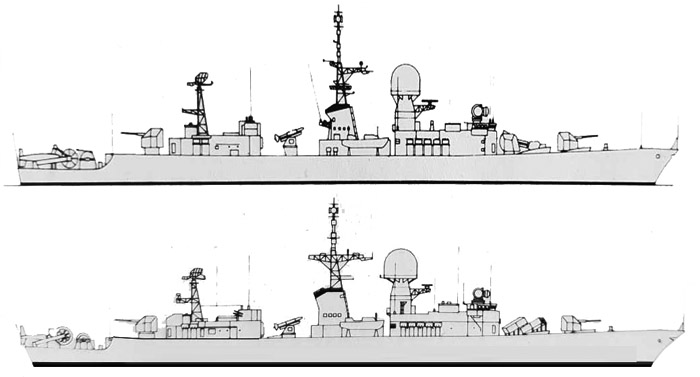
Aconit as completed and post-refit (conways)
Post 1985
She received the DRBV-15A surveillance radar which replaced the DRBV-13.
Post 1992
-DRBN34A navigation radar (replaced Decca 1226)
-DRBC-32D radar (replaced DRBC-32B)
-DSBV62C towed passive sonar added
AW Suite
As built she had a single SLQ25 Nixie towed decoy, and from the late 1970s she received the ARBR16 radar detector and two Syllex decoy launchers

Conway profile, as of 1992.
⚙ specifications |
|
| Displacement | 3,135 tonnes standard, 3,870 tonnes full load |
| Dimensions | 127 x 13.4 x 5.8m (417 x 44 ft x 19 ft) |
| Propulsion | Single Rateau steam turbine, 28,650 hp (21,364 kW) |
| Speed | 27 knots (50 km/h; 31 mph) |
| Range | 1,600 nmi (3,000 km; 1,800 mi) at 27 knots or 5,000 nmi (9,300 km; 5,800 mi) at 18 knots |
| Armament | 2× 100 mm (4 in) M1968, Malafon ASWM, 2× L5 torp. (10), quad 305 mm (12 in) ASWR see notes |
| Sensors | DRBV22A ASR, DRBV-13 SR, Decca 1226 NR, DRBC32B FCR, DUBV23 ASR, DUBV43 TAS |
| EW suite | 1× SLQ25 Nixie towed decoy, ARBR16 radar detector, 2× Syllex DL |
| Air Group | |
| Crew | 232 |
Career of FS Aconit
Aconit was laid down at Arsenal de Lorient, on 22 March 1968, launched on 7 March 1970, commissioned on 30 March 1973. Initially based at Toulon she was transferred to Brest in 1975, and redesignated from frigate F703 to D609 as pennant, on 1 January 1974. Despite the letter, she was not considered a destroyer, but a frigate until the end of her service, despite being rated at first as a corvette (C in NATO nomenclature).
The ship received several upgrades notanly in the 1970s with the ARBR-16 radar detector and two Syllex chaff launchers to icrease her survivability. In 1984–85 she underway a refit called the “Unavailability for Maintenance and Repairs” (IPER) and her now obsolete 305 mm anti-submarine mortar was replaced by eight Exocet MM40 missiles in two pairs of two canisters facing at angles forward. She also had a better DRBV-13 radar and the radome radar was just upgrade to the DRBV-15A type. In 1988 she became a Type F65 frigate.
In 1992 she had her last refit or IPER, with the new DSBV62C towed passive sonar, as well as the addition of two Oerlikon 20 mm cannon and two 12.7 mm machine guns for her close-in defence against asymetric threats. She also gained the Inmarsat and Syracuse satellite telecommunications systems with the proper antenna installed on the mainmast. The Decca 1226 navigation radar was replaced also by the DRBN34A, the DRBC-32B radar replaced by the DRBC-32D. So by 1993 she had a completely new electronics suite standardized with the rest of the fleet.
But after the end oif the cold war, budget cuts had her initially scheduled to be retired in 2004, but instead she was decommissioned on 27 February 1997, a mere few years after her last upgrade, due to the massive Fleet Reduction Programme. She was still extant however by 2010, laid up at the French Navy naval graveyard of Lanvéoc, awaiting demolition, which was completed by 24 November 2018.
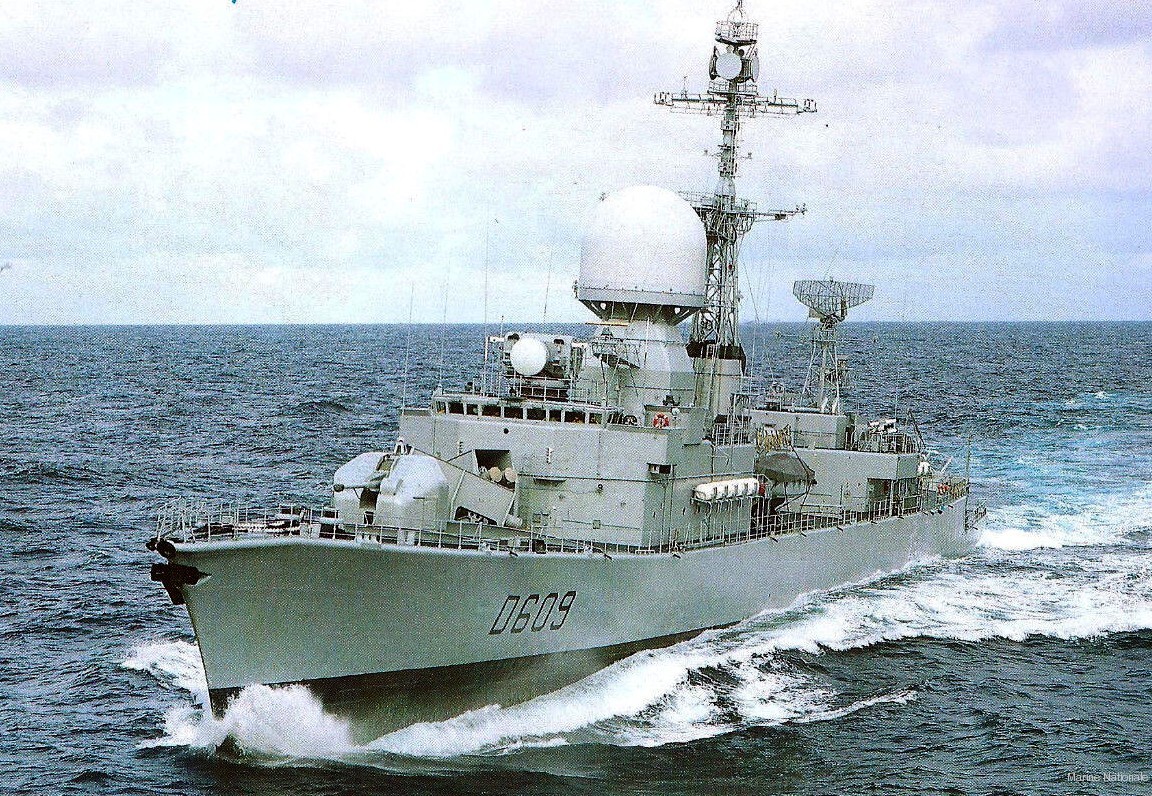
From seaforces.org, official marine nationale photo

From Flickr

From Pinterest
Read More/Src
Books
Conway’s all the world’s fighting ships 1917-95 p.113, Hugh W. Cowin
Vincent Groizeleau, «Brest: the former Aconit and BSM Rhin goes to the scrapyard» Mer et Marine, 21 november 2018 (FR).
Revue maritime 1971 : Ministère de la marine, France, Service historique 1971, p. 881
Ireland 1984 : Bernard Ireland, Navies of the West, Hippocrene Books 1984
H. Cowin Conway’s directory of modern naval power 1986 Conway Maritime Press
Herrou 1997 “Les navires de guerre. l’Union européenne” Marines Éditions 1997
Feron 2002 “100 ans de Marine Française” HS n°2, 2002
Moulin et Maurand 2008: Jean Moulin et Patrick Maurand, Les frégates anti-sous-marines. Marines Éditions 2008
Christopher Chant, A Compendium of Armaments and Military Hardware: Routledge Revivals, 2014
Jordan, John (2022). “C 65 Aconit: France’s Prototype Ocean Escort”. Warship 2022. Osprey Publishing
Links
netmarine.net index.htm
netmarine.net aconitf65 caracter.htm
meretmarine.com aconit history (most complete review) FR
https://fr.wikipedia.org/wiki/Aconit_(D609)
French Frigates list
seaforces.org D-609-FS-Aconit.htm
navypedia.org
bienpublic.com fregate aconit in libya
on nciens-cols-bleus.net/
on forum.warthunder.com/
shipspotting.com 12 3
Video
Deployments in Libya and the Persian gulf



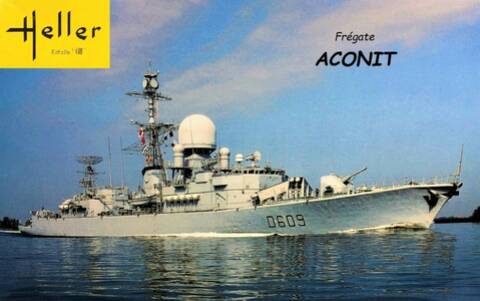
 Latest Facebook Entry -
Latest Facebook Entry -  X(Tweeter) Naval Encyclopedia's deck archive
X(Tweeter) Naval Encyclopedia's deck archive Instagram (@navalencyc)
Instagram (@navalencyc)





 French Navy
French Navy Royal Navy
Royal Navy Russian Navy
Russian Navy Armada Espanola
Armada Espanola Austrian Navy
Austrian Navy K.u.K. Kriegsmarine
K.u.K. Kriegsmarine Dansk Marine
Dansk Marine Nautiko Hellenon
Nautiko Hellenon Koninklije Marine 1870
Koninklije Marine 1870 Marinha do Brasil
Marinha do Brasil Osmanlı Donanması
Osmanlı Donanması Marina Do Peru
Marina Do Peru Marinha do Portugal
Marinha do Portugal Regia Marina 1870
Regia Marina 1870 Nihhon Kaigun 1870
Nihhon Kaigun 1870 Preußische Marine 1870
Preußische Marine 1870 Russkiy Flot 1870
Russkiy Flot 1870 Svenska marinen
Svenska marinen Søværnet
Søværnet Union Navy
Union Navy Confederate Navy
Confederate Navy Armada de Argentina
Armada de Argentina Imperial Chinese Navy
Imperial Chinese Navy Marinha do Portugal
Marinha do Portugal Mexico
Mexico Kaiserliche Marine
Kaiserliche Marine 1898 US Navy
1898 US Navy Sovietskiy Flot
Sovietskiy Flot Royal Canadian Navy
Royal Canadian Navy Royal Australian Navy
Royal Australian Navy RNZN Fleet
RNZN Fleet Chinese Navy 1937
Chinese Navy 1937 Kriegsmarine
Kriegsmarine Chilean Navy
Chilean Navy Danish Navy
Danish Navy Finnish Navy
Finnish Navy Hellenic Navy
Hellenic Navy Polish Navy
Polish Navy Romanian Navy
Romanian Navy Turkish Navy
Turkish Navy Royal Yugoslav Navy
Royal Yugoslav Navy Royal Thai Navy
Royal Thai Navy Minor Navies
Minor Navies Albania
Albania Austria
Austria Belgium
Belgium Columbia
Columbia Costa Rica
Costa Rica Cuba
Cuba Czechoslovakia
Czechoslovakia Dominican Republic
Dominican Republic Haiti
Haiti Hungary
Hungary Honduras
Honduras Estonia
Estonia Iceland
Iceland Eire
Eire Equador
Equador Iran
Iran Iraq
Iraq Latvia
Latvia Liberia
Liberia Lithuania
Lithuania Mandchukuo
Mandchukuo Morocco
Morocco Nicaragua
Nicaragua Persia
Persia San Salvador
San Salvador Sarawak
Sarawak Uruguay
Uruguay Venezuela
Venezuela Zanzibar
Zanzibar Warsaw Pact Navies
Warsaw Pact Navies Bulgaria
Bulgaria Hungary
Hungary

 Bundesmarine
Bundesmarine Dutch Navy
Dutch Navy Hellenic Navy
Hellenic Navy Marina Militare
Marina Militare Yugoslav Navy
Yugoslav Navy Chinese Navy
Chinese Navy Indian Navy
Indian Navy Indonesian Navy
Indonesian Navy JMSDF
JMSDF North Korean Navy
North Korean Navy Pakistani Navy
Pakistani Navy Philippines Navy
Philippines Navy ROKN
ROKN Rep. of Singapore Navy
Rep. of Singapore Navy Taiwanese Navy
Taiwanese Navy IDF Navy
IDF Navy Saudi Navy
Saudi Navy Royal New Zealand Navy
Royal New Zealand Navy Egyptian Navy
Egyptian Navy South African Navy
South African Navy






























 Ukrainian Navy
Ukrainian Navy dbodesign
dbodesign